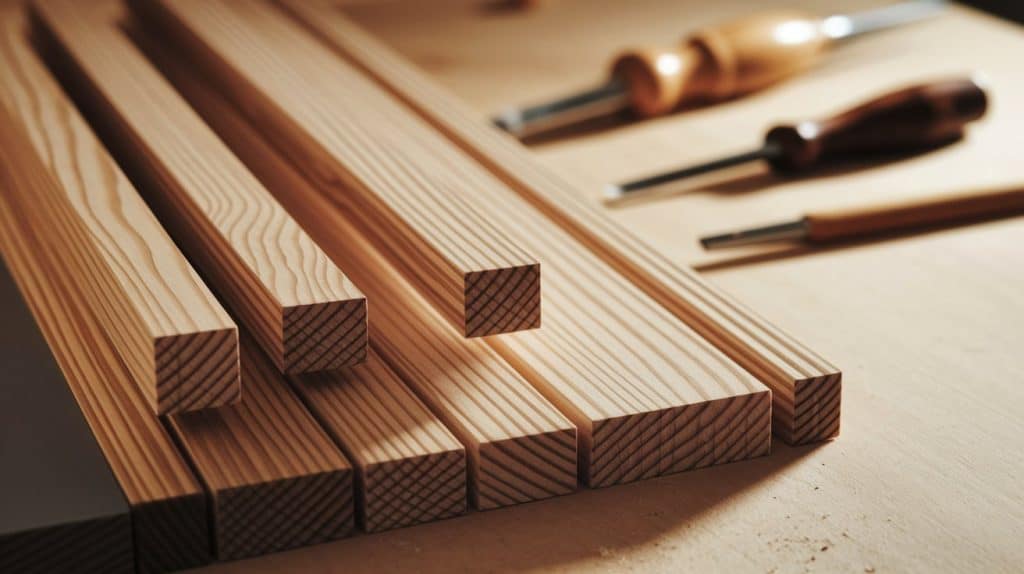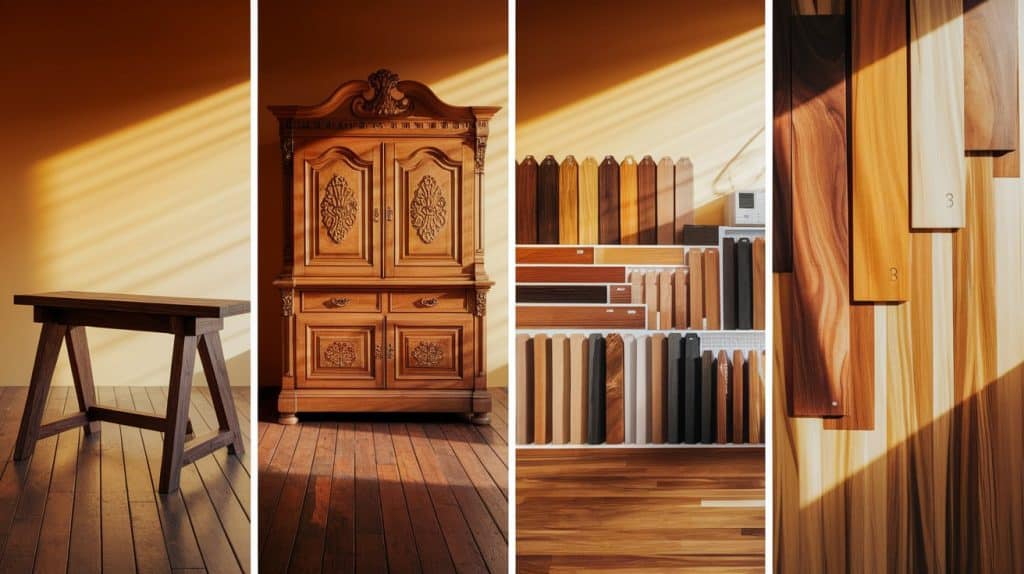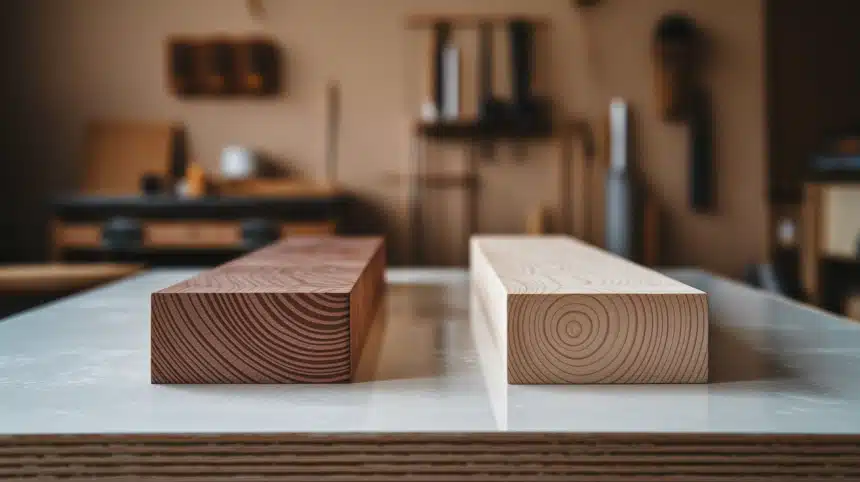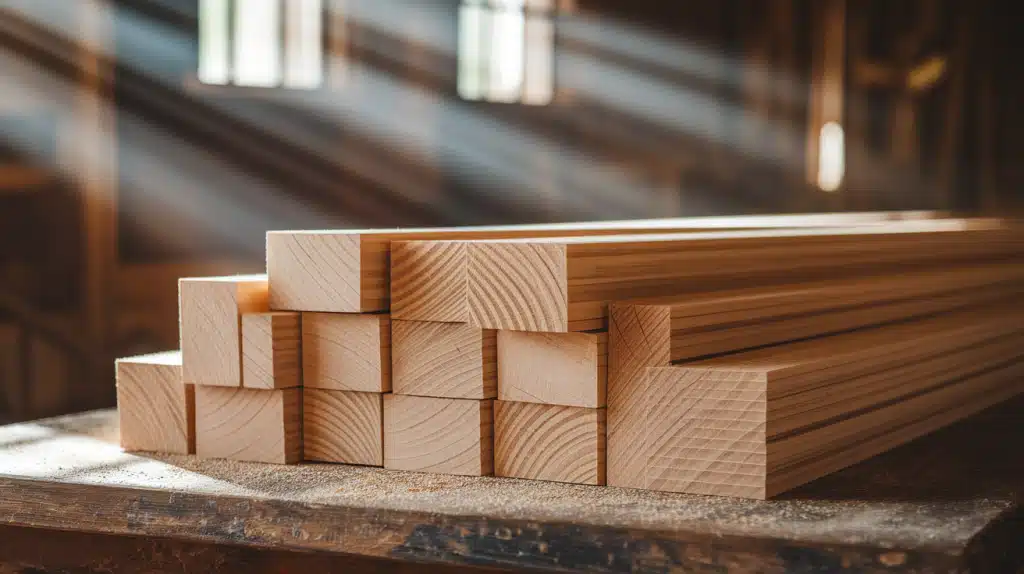If you’ve ever shopped for hardwood or tried a DIY woodworking project, you may have come across terms like plain sawn and quarter sawn.
At first glance, they might sound technical, but they’re actually simple concepts that can make a big difference in how your project turns out.
Plain sawn and quarter sawn refer to how a board is cut from a log. This cutting method affects the wood’s appearance, strength, cost, and even how it reacts to moisture over time.
This guide is made for beginner DIYers, homeowners, and budding woodworkers who want to understand the basics without the jargon.
What is Plain Sawn Lumber?
Plain sawn lumber, also called flat sawn, is the most common and cost-effective way of cutting a log into boards.
Due to its straightforward production and attractive grain pattern, it’s widely used in furniture, flooring, and construction.
The saw runs straight through the log in parallel slices from top to bottom, resulting in minimal waste and maximum board width, making it efficient and affordable.
Common Visual Characteristics
- Cathedral or flame-like grain patterns across the face
- Wider grain spacing, often with a flowing or curved look
- Boards may have varying grain directions within the same piece
These natural patterns are popular for decorative uses, especially in tabletops, panels, and rustic furniture.
Advantages of Plain Sawn Lumber
- More affordable than quarter or rift-sawn lumber
- Less waste during production, making it eco-friendly
- Wider boards are easier to obtain
- Popular grain appearance for traditional aesthetics
Drawbacks of Plain Sawn Lumber
- Less stable, more prone to cupping, warping, or twisting
- Higher movement with changes in humidity
- Not ideal for high-moisture areas like bathrooms or basements
What is Quarter Sawn Lumber?

Quarter-sawn lumber is a premium wood cutting method known for its straight grain, superior stability, and unique visual appeal.
It’s often used in high-end furniture, fine cabinetry, musical instruments, and historic restorations.
Quarter-sawn boards are made by first cutting the log into quarters lengthwise, like pie slices.
Then, boards are cut from each quarter at a 60–90° angle to the growth rings. This method results in narrower boards with vertical grain and greater uniformity.
Distinct Grain and Appearance
- Straight, tight grain that runs vertically
- Medullary rays or “ray flecks” are often visible, especially in oak
- More consistent pattern across each board
- Has a refined, formal look ideal for classic or custom pieces
This visual uniformity makes quarter-sawn wood especially attractive for projects where grain symmetry matters.
Pros of Quarter Sawn Lumber
- Exceptional stability resists warping, cupping, and twisting
- Expands and contracts less with moisture changes
- Elegant appearance with unique ray flecking in certain species
- Great for detailed woodworking, joinery, and finishing
Cons of Quarter Sawn Lumber
- More expensive due to extra labor and lower yield
- Narrower boards, which may require more joining
- Not as widely available in big-box stores
Key Differences Between Plain Sawn and Quarter Sawn Wood
Choosing between plain sawn and quarter sawn lumber comes down to four main factors: how the grain looks, how stable the wood is, how much it costs, and the overall aesthetic appeal.
Here’s a side-by-side comparison to help you decide:
| Feature | Plain Sawn Wood | Quarter Sawn Wood |
|---|---|---|
| Grain Pattern | Wavy, cathedral-like curves | Straight, tight lines; ray flecks in some species |
| Stability & Movement | Less stable; prone to cupping and warping | Highly stable; resists twisting and moisture shifts |
| Cost & Availability | More affordable and widely available | More expensive; limited supply |
| Aesthetic Appeal | Rustic, traditional look | Clean, elegant, and often formal appearance |
On the other hand, quarter-sawn wood is a better match for fine furniture, heirloom pieces, and settings where precision and beauty matter most.
Which One Should You Choose?

Deciding between plain sawn and quarter sawn lumber depends on the type of project you’re tackling and what matters most: appearance, durability, or budget.
Here’s how to make the right choice based on common woodworking goals:
For Furniture and Cabinetry
- Quarter-sawn wood is a top choice for fine furniture and cabinetry. Its straight grain and superior stability make it ideal for doors, drawer fronts, and panels that need to stay flat over time.
- If you’re aiming for a rustic or traditional look, plain sawn wood works well and offers plenty of visual character.
For Flooring
- Quarter-sawn flooring performs better in areas with humidity changes due to its reduced expansion and contraction.
- Plain sawn flooring is more budget-friendly and still looks beautiful, though it may be more prone to movement.
For Visible Grain Patterns
- If your goal is to showcase a bold, flowing grain, plain sawn delivers with its dramatic cathedral patterns.
- Prefer clean, linear grain with occasional shimmering ray flecks? Go with quarter-sawn for a refined touch.
For Budget-Friendly Projects
- Plain sawn lumber is the most economical and widely available option, making it perfect for large-scale or budget-conscious builds.
- Quarter-sawn wood, while premium, may not be worth the extra cost unless stability or appearance are critical.
Why Grain Direction Matters in Woodworking
Grain direction plays a major role in how wood behaves and how your finished project looks and lasts. If you’re staining, cutting, or simply hoping your furniture doesn’t warp with time, understanding the grain is key to better results.
The Role of Grain in Durability and Finish
- Durability: Wood is stronger and more stable along the grain. When grain is consistent (as in quarter-sawn lumber), the board resists bending, warping, and cracking. Uneven or varied grain (as in plain sawn) may lead to structural movement over time.
- Finish Quality: Straight grain tends to absorb stain more evenly and predictably. Boards with inconsistent grain may absorb finish unevenly, leading to blotchy results unless properly pre-treated.
A smooth, straight grain provides better control and strength, especially important for joints, panels, and load-bearing parts.
Conclusion
Plain sawn boards feature bold grain, wider widths, and are more affordable. They are ideal for rustic pieces, wall panels, or general builds.
Quarter-sawn boards, in contrast, work best where strength, stability, and tight grain patterns matter, think cabinetry, heirloom pieces, or long-lasting floors.
If you’re starting, focus on what matters most for your project: looks, budget, or lasting quality. A little knowledge about each cut gives you a solid head start on making smart woodworking choices.
Do you have questions or tips on working with different cuts of wood? Comment below, we’d love to hear from you!
Frequently Asked Questions (FAQS)
Is Quarter-Sawn Wood Always Better than Plain-Sawn Wood?
Not always. Quarter sawn is more stable and decorative, but plain sawn is cost-effective and great for projects where grain direction and stability aren’t critical.
Can I Use Plain Sawn Wood for Flooring?
Yes, but it’s more prone to movement. For better performance and longevity, use it in low-moisture areas and ensure proper sealing.
How Do I Tell if Wood is Quarter-Sawn?
Look for straight grain lines and shimmering ray flecks (especially in oak). The grain runs vertically across the face of the board.


